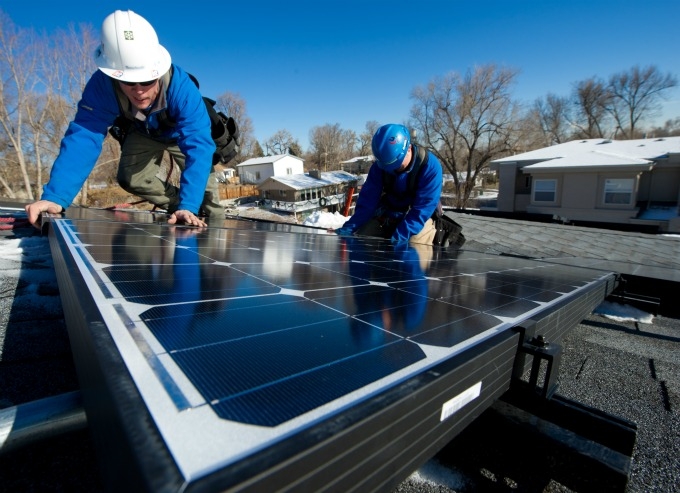By in Energy Conservation, Green Living, Save Mone
10 Ways Green Living Seniors Save Money
1) Energy – Green living seniors use less energy to heat, cool, light, and power their homes. That means they have taken steps to: insulate attics and crawl spaces; weatherstrip windows and doors; install curtains or blinds over windows on the north (cold) side of the house, and awnings and shades on the south (hot) side. Green living seniors also use a programmable thermostat to make it easy to automatically reduce energy consumption when they’re not home. This model, the Nest, is one option.
2) Water – Green living seniors don’t waste money buying bottled water, which ounce for ounce can cost 10,000 times more than tap water. Instead, they have made a one-time purchase of a water filter and fill their own reusable bottles and pitchers with filtered tap water. Depending on how much bottled water they previously bought, these smart seniors could be saving $10 or more a week.
3) Food – According to the U.S. Department of Agriculture, most consumers throw away at least 30% of the food they buy because they forget about it and it spoils, or it passes its expiration date. Green seniors keep track of what’s in their fridge and pantry; find yummy ways to enjoy leftovers; and shop from grocery lists so they don’t buy too much in the first place. They also buy from the bulk bins, where they can buy as much or as little as they need and avoid the excess packaging that also drives up the price of our food.
4) Cars, Car/Van Pooling, and Car Sharing – Seniors living together who retire often find that they no longer need two cars, or don’t need their own car as much as before. It’s more economical to maintain and fuel only one car, and to take advantage of the van pools that many communities now offer their senior citizens. Plus, with the expansion of car sharing services like Zip Car, it is becoming much more convenient to share cars rather than maintain your own. This is particularly true with Zip Car. You pay an annual membership fee and an hourly use for the vehicle. But you don’t pay for insurance, gas or oil, new tires, or maintenance.
5) Bicycling – In retirement, seniors find they have more time and interest in bicycling for recreation or to get chores done. It’s a great oil-free, pollution-free way to get around town without having to spend money on gasoline, and of course, it will keep you in shape.
6) Mass Transit – Cities that have mass transit systems usually offer seniors big discounts for taking the bus or subway. Check with your municipality to see when the discount kicks in. In Washington, D.C., it’s age 65, but it could be as early as 60 or 62 where you live.
 7) Downsize – Downsizing to a smaller home or apartment probably saves the most money on heating, cooling, and maintenance. The environmental benefits can’t be beat either, since a smaller dwelling has a smaller carbon footprint, and will use less water (fewer bathrooms? less lawn to water?) and require less “stuff” in terms of furnishings, paint, cleaning products and more.
7) Downsize – Downsizing to a smaller home or apartment probably saves the most money on heating, cooling, and maintenance. The environmental benefits can’t be beat either, since a smaller dwelling has a smaller carbon footprint, and will use less water (fewer bathrooms? less lawn to water?) and require less “stuff” in terms of furnishings, paint, cleaning products and more.
8) Extra Care Communities – Rather than downsize to a smaller home, many seniors are opting to move into retirement communities which are already designed to save energy and other resources, and make it easy to bicycle or take van pools rather than drive. Some communities specialize in eco-friendly dwellings and offer their residents organic gardening options and opportunities to volunteer on green projects. Others maximize energy efficiency through wise construction practices, community design, and use of LED lights and water-saving appliances.
9) Travel – Green living seniors in the U.S. who have a sense of adventure can enjoy many opportunities to volunteer with the National Park Service or the National Wildlife Refuge System. In some parks, you can camp at low or no cost in exchange for volunteer services. If you put in 250 hours over the course of a year, you’ll earn a free annual pass to national parks and other wilderness and wildlife destinations. At the age of 62, for just $10, you can buy a lifetime pass that will gain you free entry to the nation’s national parks, wildlife refuges, and Bureau of Land Management public lands.
10) Library – Libraries offer seniors an absolutely free way to access almost any information you want. If you don’t have a computer, use one at the library. Rather than buy a book, borrow it. The same goes for movies and music. Plus, use the library to read your favorite magazines and newspapers. You’ll save money on the buying side, and do your part to cut back on the amount of paper that needs to be printed, since you’ll be sharing all these materials rather than owning them outright. If you have an e-reader, you can probably download a lot of what you want from the library’s website so you don’t have to make the visit there if you don’t want to.
– See more at: http://www.biggreenpurse.com/green-living-seniors/#sthash.Ylbq7nSp.dpuf






